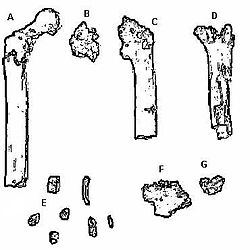Orrorin
|
Orrorin tugenensis Temporal range: Late Miocene, 6.1–5.7 Ma |
|
|---|---|
 |
|
| Orrorin tugenensis fossils | |
| The distal phalanx of the thumb. | |
| Scientific classification | |
| Kingdom: | Animalia |
| Phylum: | Chordata |
| Class: | Mammalia |
| Order: | Primates |
| Family: | Hominidae |
| Subfamily: | Homininae |
| Tribe: | Hominini |
| Genus: |
†Orrorin Senut et al. 2001 |
| Species: | †O. tugenensis |
| Binomial name | |
|
†Orrorin tugenensis Senut et al. 2001 |
|
Orrorin tugenensis is a postulated early species of Homininae, estimated at 6.1 to 5.7 million years (Ma) and discovered in 2000. It is not confirmed how Orrorin is related to modern humans. Its discovery was an argument against the hypothesis that australopithecines are human ancestors, as much as it still remains the most prevalent hypothesis of human evolution as of 2012.
The name of genus Orrorin (plural Orroriek) means "original man" in Tugen, and the name of the only classified species, O. tugenensis, derives from Tugen Hills in Kenya, where the first fossil was found in 2000. As of 2007, 20 fossils of the species have been found.
The 20 specimens found as of 2007 include: the posterior part of a mandible in two pieces; a symphysis and several isolated teeth; three fragments of femora; a partial humerus; a proximal phalanx; and a distal thumb phalanx.
Orrorin had small teeth relative to its body size. Its dentition differs from that found in Australopithecus in that its cheek teeth are smaller and less elongated mesiodistally and from Ardipithecus in that its enamel is thicker. The dentition differs from both these species in the presence of a mesial groove on the upper canines. The canines are ape-like but reduced, like those found in Miocene apes and female chimpanzees. Orrorin had small post-canines and was microdont, like modern humans, whereas robust australopithecines were megadont.
...
Wikipedia

